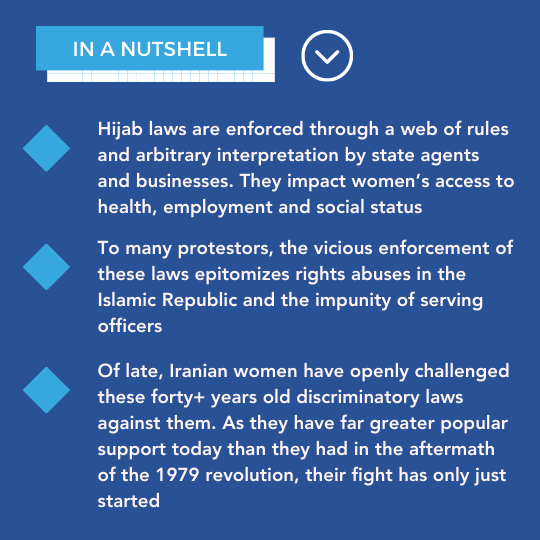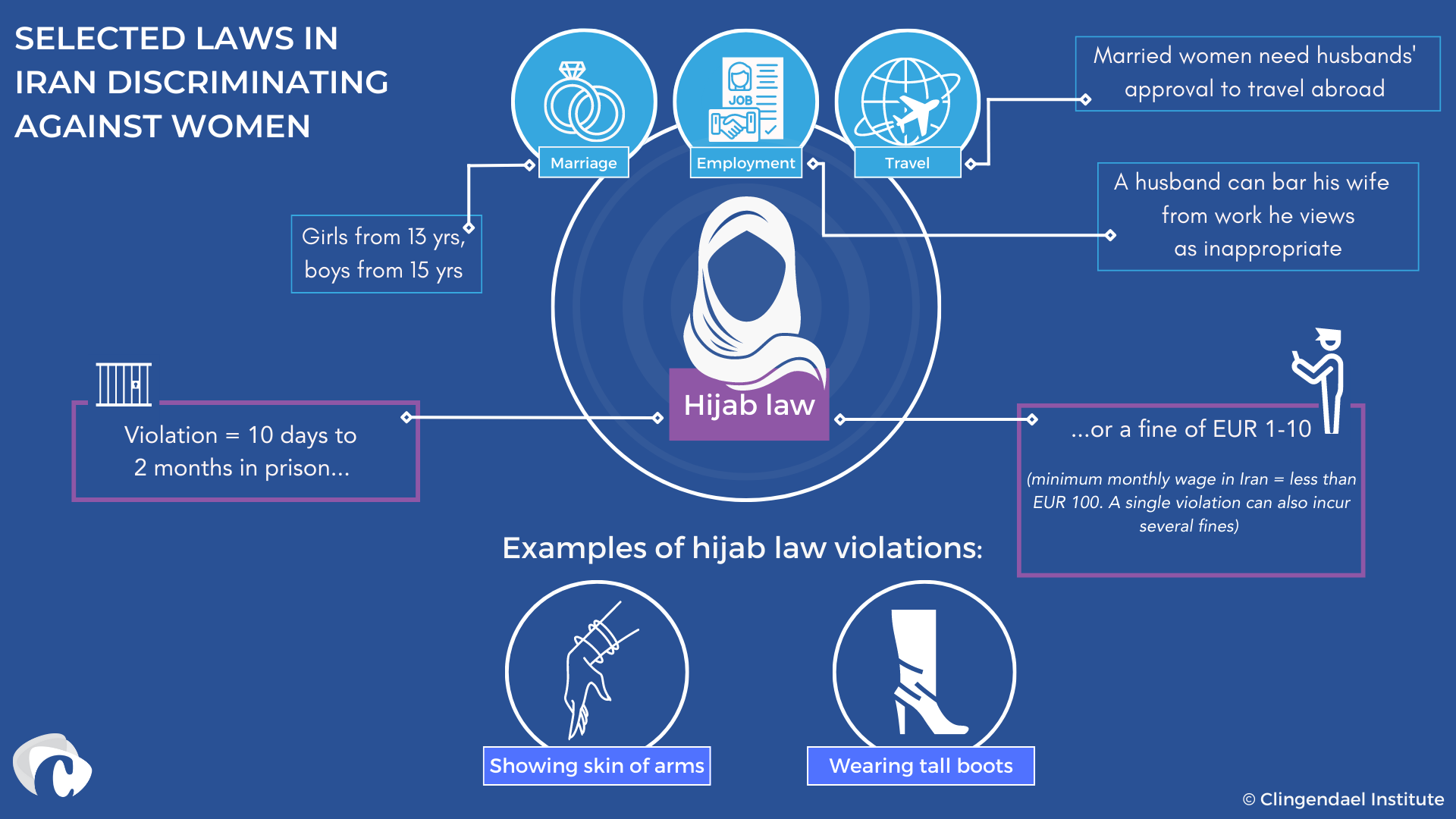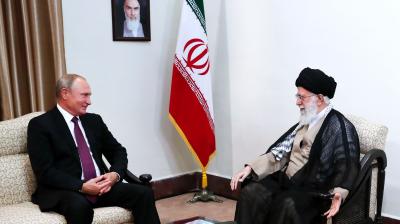Unveiling resistance: The struggle for women's rights in Iran
Welcome to the fourth edition of Clingendael’s blog ‘Iran in transition’ that tracks different dimensions of the evolution of protests and governance in Iran. In our previous blog, Mahdi Ghodsi examined the state of Iran’s economy with regard to the transitional state the country has entered into since the 2022/2023 protests. In this blog, Tara Sepehri Far takes a hard look at the evolution of women’s right in Iran and analyses some of its effects on social justice and protests.

Introduction
The sweeping public protests that erupted across Iran in response to the death of Mahsa (Jina) Amini in custody of Iran’s morality police last September have been characterized by many observers as the first feminist uprising in the region. The visually powerful images of women and girls defying compulsory hijab laws in the streets and the slogan “women, life, freedom” have strengthened this characterization and drawn broad international sympathy. But the sweeping protests and their demands for fundamental change were met with a brutal government crackdown that resulted in hundreds of deaths and tens of thousands of arbitrary arrests. Almost nine months later, women’s right to choose their own way of dressing remains at the center of the protest movement. Understanding why requires a closer look at how the broader struggle of women for equal rights in Iran has evolved over the years.
Charting the course of women's rights movement in Iran
Iranian women experience discrimination in law and in practice in ways that deeply impact their lives, particularly with regard to marriage, divorce and custody issues. Post-1979 compulsory hijab laws affect virtually every aspect of women’s public life in Iran. In today’s Iran, a woman’s access to employment, education, social benefits and proper health care — and even her mere public presence in society— depends on complying with compulsory hijab laws, which are routinely enforced through a web of rules and arbitrary interpretation by state agents as well as businesses. However, despite its overarching impact on women’s rights and freedoms, the choice of dress code as a right was not taken up by Iran’s women’s movement as a collective issue until recently. Instead, the battle against enforcement of the compulsory wearing of the hijab was largely fought by the individual acts of millions of women, including activists, across the country - rather than via groups or institutions.
Iran has a decades-long history of movements promoting women’s rights, both before and after the revolution of 1979. Most of them pursued a vision of equality under law and sought to redress the gap regarding legal protection by promoting international human rights instruments. The most notable example after the revolution is the coalition of Islamist and secular feminist activists who came together to establish the “One Million Signature Campaign to Demand the Repeal of Discriminatory Laws” in 2006. Focus issues included age discrimination in establishing criminal responsibility and marriageable age, inequality in inheritance and discrimination of mothers as guardians in case of divorce. The issue of the compulsory hijab was notably absent. While the “One Million Signature Campaign” did not achieve its stated goal of fully repealing the set of relevant laws, it created strong bonds among students and labor activists and trained a generation of activists in legal advocacy. Similar to other movements, this group of activists came under significant state pressure and faced large-scale arrests during the Ahmadinejad presidency.
The pressure on the movement combined with the repression that followed the 2009 presidential election protests increasingly foreclosed avenues for legal reforms and led dozens of human rights defenders and activists to go into exile. It also shifted the focus of women’s rights defenders towards promoting women’s representation, including the presence of women in public life. During the presidency of Hassan Rouhani, Shahindokht Molaverdy, the then-vice president for women and family affairs and a figure close to the women’s rights movement, came under immense pressure from the judiciary to prevent any such change and was only able to take minor steps in advancing women’s rights. During this period, the women’s movement focused most of its activities on achieving more representation in elected positions, greater women’s attendance of sporting events, and better protection against sexual harassment in public as well as work spaces.
Digital dissent: How social media changed the movement
The expansion of internet access in Iran has been integral to the next shift in activism. It has enabled millions to share information outside official channels of communication and also blurred the line between the public and the private as it enables youth and women to blog about their lived experiences and share images of ordinary life on social media. Despite state-imposed internet restrictions, popular social media platforms such as Instagram, are used widely by lifestyle bloggers, women-led businesses, and public figures to promote their activities. Millions of Iranians use VPNs to circumvent internet censorship.
This shift from legal advocacy to digital social protest continues to push the boundaries of the social debate in public life. Since the summer of 2020, dozens of Iranian women from various backgrounds have taken to social media to share their stories of sexual harassment and assault by influential men in various industries. They have formed their own #metoo movement and achieved the arrests of a number of those accused of harassment, community condemnations, and exoneration of two actresses who had faced defamation charges for speaking up.
It was also this shift in women’s rights discourse and the accompanying expansion of online platforms that empowered the exiled activist Masih Alinejad to initiate formal campaigns against the compulsory hijab starting in 2014. The issue was forced to the center of the political debate in December 2017, when 31-year old Vida Movahed stood on a metal utilities box on Enghelab (Revolution) Street in central Tehran without a hijab and silently waved a white scarf from a stick, sparking a series of acts of bold defiance by women who became known as the girls of revolution street.
The compulsory hijab and state-society relations in Iran
Iran’s penal code criminalizes appearance of women in public space without “sharia hijab”. The offense is punishable by a fine, or imprisonment between 10 days to two months. According to a government-linked survey that was conducted in 2014, almost half of the respondents took the view that the government should not intervene on the issue. The corresponding figure in 2005 was 34%. A more recent report published by the parliamentary research center states that 70 percent of Iranian women do not abide by the government’s interpretation of hijab regulations under Islamic law. The report also flags the risk that further criminalization of disobeying sharia hijab legislation can weaken government’s social legitimacy. Despite officials’ admission that Iranians’ views are shifting, enforcement of the hijab remains an article of faith among hardliners in Iran. The government has invested significant resources in promoting and enforcing hijab laws, as well as initiated harsh crackdowns against those who peacefully mobilize against them. Government propaganda equates observance of hijab with the preservation of family values and traditional social structures.
Recently pronounced prolonged sentences against human rights defenders for peacefully opposing the hijab, as well as viral scenes of police violence against women and girls who do not abide by compulsory hijab have contributed to public frustration and stoked political dissent. The 2021 elections, which solidified the control of hardliners, also gave rise to a wave of enforcement of repressive laws against women, including hijab compliance. In July 2022, a video of 28-year old Sepideh Rashno resisting harassment and vigilante enforcement of the compulsory hijab on a bus went viral. Rashno was arrested and, a month later, dragged in front of cameras to apologize. In the footage, Rashno looked pale and had dark circles around her eyes. Instead of instilling fear among Iranian women, social media responses to the incident suggest it rather created widespread indignation.

In many ways, continued enforcement of the compulsory hijab can be viewed as the quintessential symbol of popular disconnect with the Islamic republic: Amid the government’s mounting inability to meet people’s basic needs, an increasingly unpopular and abusive policy remains imposed on people and is enforced with impunity by state agents. In that sense, the fate of Mahsa (Jina), a young woman wearing an outfit considered unremarkable to many, was one that could befall many Iranian women or their loved ones. Protesters saw her death at the hands of morality police not as an accident, but as the result of a systemic pattern of brutal violation of women’s right that is exercised with both callousness and impunity.
Those who took to the street in protest to demand fundamental change included political and social elites that had hesitated to join earlier street protests. Now they showed support by removing their headscarves in public. This established an important thread of continuity between earlier protest movements – as discussed above - and the present defiance of women of compulsory hijab laws. The women and girls on the street view their individual acts of resistance as connected to a broader struggle. Ultimately, the matter of the hijab is not just about women claiming back the right to dress as they wish from the state, or about advocating for the elimination of a set of abusive state enforcement practices. Rather, the real stakes are a multilayered fight for the rewriting of the social laws, codes and practices that determine a women’s life and place in society, including within families. For example, nine months after her release, Rashno wrote on her Instagram page how, during her detention, her conservative brother and father had come closer to supporting her cause. Several other women have written about how the movement has enabled new conversations with their families about their choice of dress, their position at home and their role in society.
Is fundamental change imminent?
It is precisely because the matter is much more fundamental than a choice of clothes that the Iranian government has not shown signs of reversing course. The authorities have responded to the mounting resistance against the compulsory hijab with an array of policies and draft legislation that seek to increase enforcement of the compulsory dress code through facial recognition detection, pressure on businesses to enforce laws, and punishments that include fines and deprivation of social benefits for those who refuse to comply. This vision was clearly outlined in a policy document prepared by the government’s Headquarters for the Promotion of Virtue and Prevention of Vice in 2021, which seeks to reduce public tension while expanding enforcement outside the legal arena. The impact of these new restrictions remains to be seen, but it is likely that they will disproportionally affect economically marginalized women due to the additional financial burdens they will impose.
However, in a context of mass demonstrations, it is difficult to see how the legitimacy of current regulations can be restored, let alone new ones added. The movement of ‘women, life, freedom’ has demonstrated the unifying power and potential of women’s rights as lever for mobilization and demands for change. This has made the quest for such rights an essential part of any pathway towards fundamental change. Over forty years ago, women’s rights defenders failed to gain the support of political parties in their protests against the imposition of the compulsory hijab. Today’s Iranian women that are determined to change the social norms imposed by legislation dating back to 1979 enjoy far broader social support. Recent events show how they have become active agents in pursuit of their rights, and seek to drive change even in the absence of a political transformation.
Stay tuned for the next blog. Subscribe to our Middle East Updates.



